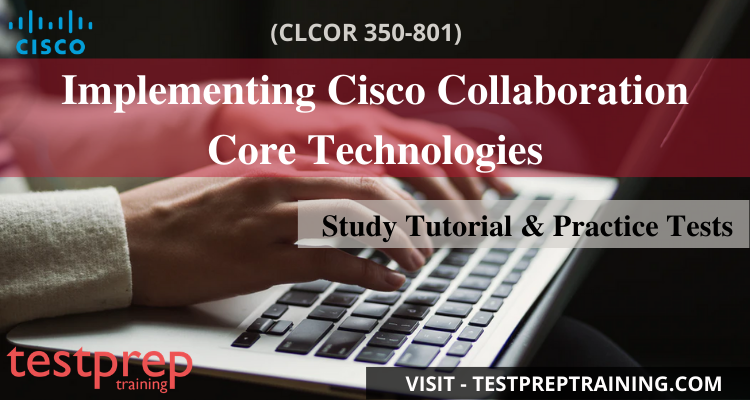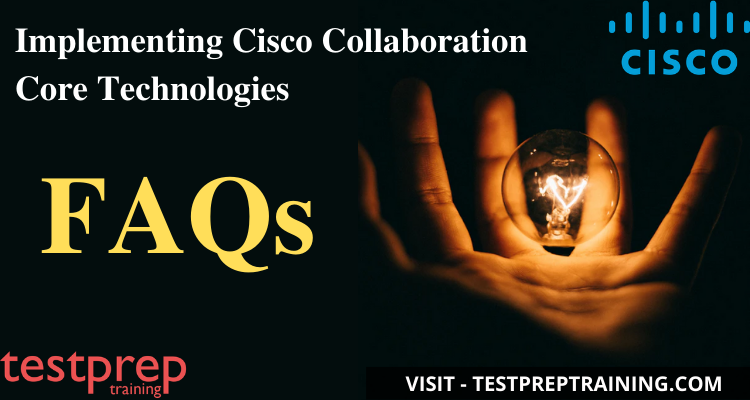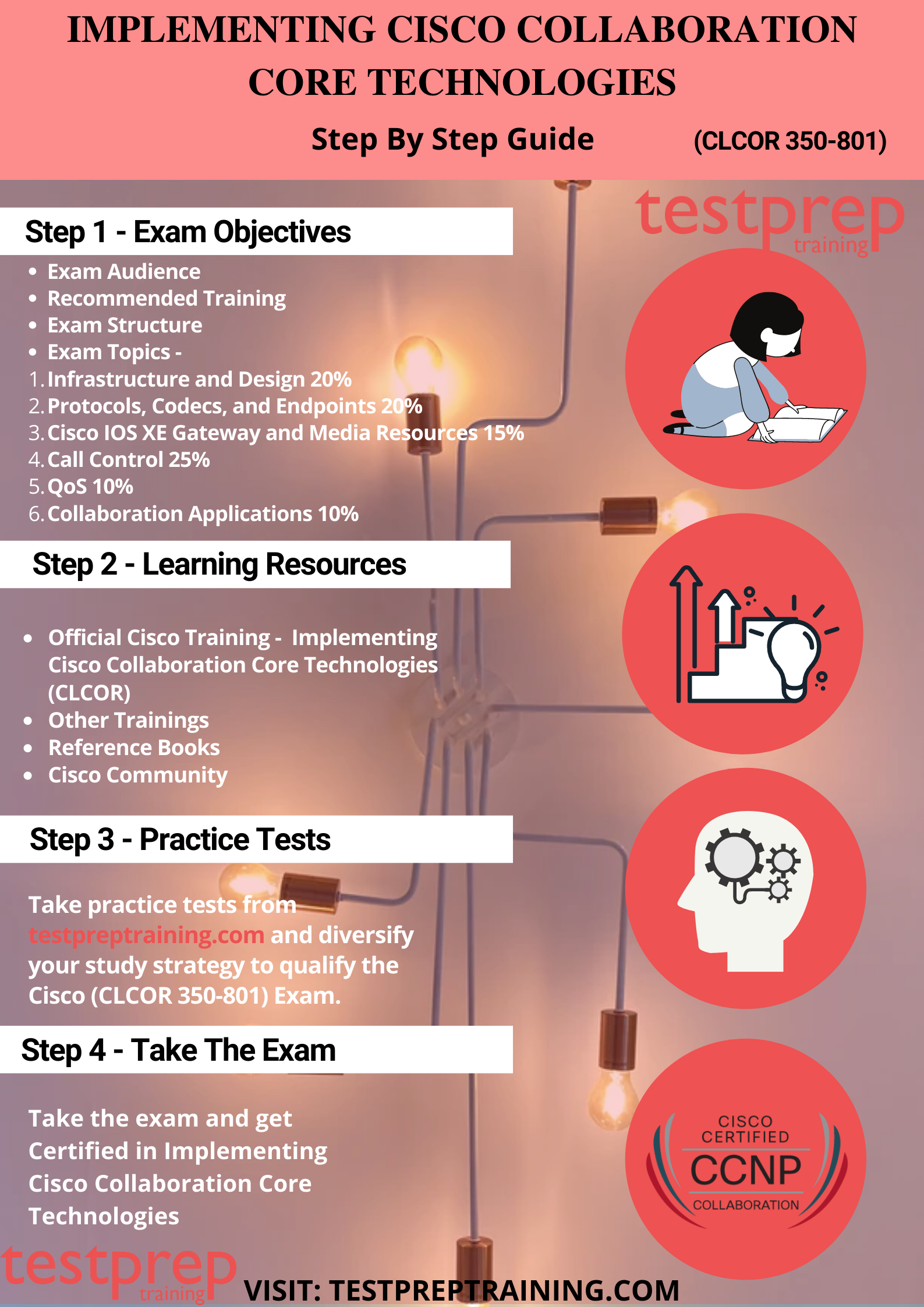CLCOR 350-801 | Implementing Cisco Collaboration Core Technologies

The CLCOR 350-801 | Implementing Cisco Collaboration Core Technologies certification exam is designed in association with the CCNP and CCIE Collaboration certifications. Through this exam, a candidate will gain the knowledge and skills required to implement and deploy core collaboration and networking technologies. This examination tests a candidate’s knowledge and proficiency in handling and implementation of core collaboration technologies that comprises QoS, Collaboration applications, Call Control, Protocols, codecs and endpoints, infrastructure and design, Cisco IOS XE gateway and media resources.
Target Audience
The Cisco (CLCOR 350-801) Certification exam is for the following individuals –
- Students preparing to take the CCNP Collaboration certification
- Network administrators
- Network engineers
- Systems engineers
Recommended Knowledge
The candidate undergoing this exam should have a specializing familiarity with the basic terms of computer networking comprising LANs, WANs, switching, and routing. They must be well versed with the fundamentals of digital interfaces, Public Switched Telephone Networks (PSTNs) and Voice over IP (VoIP). The learners must possess a basic understanding of converged voice and data networks and Cisco Unified Communications Manager deployment.
Cisco (CLCOR 350-801) Exam Policies
We shall now discuss some of the important policies related to exam results, assignment, retake policy and certification process.
Exam Result
Right after completing your exam, you will receive your score report which will be imprinted with your digital photo, captured during admission. The result will also contain a section-wise score breakout along with the passing score. You will have the option to share this photo-imprinted score reports with employers. You can also decide to provide them with preferred online access, for verification purposes, at the Authenticate score report. You can confirm the online photo and exam score results on the Pearson VUE candidate tracking webpage. This is an official method.
Exam Retake Policy
If you fail in the exam of Associate, Professional, Specialist, or CCDE level, then you must wait for a period of five (5) calendar days, before becoming eligible for taking a re-attempt. Once you have passed the exam, you must wait for a minimum of 180 days before becoming eligible to take the same exam, with an identical exam number. Candidates failing in an Online / Un-Proctored Cisco (700-xxx series) exam will have to wait for forty-eight hours (48hrs) before retesting the same exam.
Re-certification
Your Cisco (CLCOR 350-801) certification will be valid only for a period of three years. After three years you will have to re-certify yourself to gain desired benefits. You can re-certify yourself by completing education activities, by taking exams, or by a combination of both. These are the ways available for re-certification.
- Take an exam
- Attend Cisco Live training sessions
- Author content
- Complete online training courses
- Complete instructor-led training
- Three-year re-certification requirement
For More Details See – Cisco CLCOR 350-801 FAQ

Cisco (CLCOR 350-801) Exam Details
| Exam Name Implementing Cisco Collaboration Core Technologies | Exam Code 350-801 CLCOR |
| Exam Duration 120 mins | Exam Format Multiple Choice |
| Eligibility/Pre-Requisite Working knowledge of fundamental terms of Computer networking, Data networks, and CiscoUnified Communications Manager deployment | Number of Questions 55-65 |
| Exam Language English | Exam Fee $400 USD |
Cisco (CLCOR 350-801) Course Outline
We shall now discuss the prescribed course outline for Cisco (CLCOR 350-801) exam.
Infrastructure and Design [20%]
1.1 Describe the key design elements of the following, pertaining to the Cisco Collaboration architecture as described in the SRND/PA
Cisco Documentation: Cisco Collaboration Solutions Design Guidance
- Licensing (Smart, Flex)
- Sizing (Cisco Documentation: Collaboration Solution Sizing Guidance)
- Bandwidth (Cisco Documentation: Network Infrastructure)
- High availability (Cisco Documentation: Preferred Architecture for Cisco Collaboration)
- Disaster recovery
- Dial plan (Cisco Documentation: Dial Plan)
- Security (certificates, SRTP, TLS) (Cisco Documentation: Cisco Collaboration Security)
- QoS (Cisco Documentation: Quality of Service Design Overview)
1.2 Describe the purpose of Edge devices in the Cisco Collaboration architecture such as Expressway and Cisco Unified Border Element (Cisco Documentation: Collaboration Edge, Overview of Cisco Unified Border Element)
1.3 Configure these network components to support Cisco Collaboration solutions
- DHCP (Cisco Documentation: DHCP server setup)
- NTP (Cisco Documentation: NTP Troubleshooting)
- CDP
- LLDP (Cisco Documentation: Configuring LLDP)
- LDAP (Cisco Documentation: Directory Integration and Identity Management)
- TFTP (Cisco Documentation: Configure TFTP Servers, Call Processing)
- Certificates
1.4 Troubleshoot these network components in a Cisco Collaboration solution
- DNS (A/AAA, SRV, Reverse Pointer Record (PTR))
- NTP
- LDAP integration on Cisco Unified Communications Manager (Cisco Documentation: LDAP Synchronization Overview)
1.5 Explain these components to support Cisco Collaboration solutions
- SNMP (Cisco Documentation: Cisco Unified CM SNMP, Network Management)
- DNS (Cisco Documentation: Network Infrastructure)
Protocols, Codecs, and Endpoints [20%]
2.1 Troubleshoot these elements of a SIP conversation
- Call set up and tear down (Cisco Documentation: Configure and Troubleshoot Basic Call Recording, Configuring SIP Call-Transfer Features)
- SDP (Cisco Documentation: Troubleshoot a SIP Call Between Two Endpoints)
- DTMF (Cisco Documentation: DTMF Relay and Interworking on CUBE, DTMF Relay)
2.2 Identify the appropriate collaboration codecs for a given scenario (Cisco Documentation: Introduction to Codecs)
2.3 Configure codec negotiations (Cisco Documentation: Codec Preference Lists)
2.4 Deploy SIP endpoints
- Manual
- Self-provisioning (Cisco Documentation: Configure Self-Provisioning)
- Bulk Administration Tool (BAT) (Cisco Documentation: Cisco Unified Communications Manager Bulk Administration Tool (BAT))
2.5 Troubleshoot collaboration endpoints
Cisco IOS XE Gateway and Media Resources [15%]
3.1 Configure these voice gateway elements
- DTMF (Cisco Documentation: DTMF Relay)
- Voice translation rules and profiles (Cisco Documentation: Voice Translation Rules, Number Translation using Voice Translation Profiles)
- Codec preference list (Cisco Documentation: Codec Preference Lists)
- Dial peers (Cisco Documentation: Dial Peer Configuration)
3.2 Configure ISDN PRI/BRI (Cisco Documentation: Configuring ISDN BRI)
3.3 Troubleshoot ISDN PRI/BRI (Cisco Documentation: Troubleshooting ISDN BRI Layer 1)
3.4 Configure and verify the MGCP (Cisco Documentation: Configure and Troubleshoot MGCP Gateways)
3.5 Identify the appropriate media resources for a given scenario (hardware and software) (Cisco Documentation: Media Resources)
Call Control [25%]
4.1 Describe the Cisco Unified Communications Manager digit analysis process (Cisco Documentation: Understanding and Troubleshooting Call Routing and Dial Pattern, Cisco Unified Communications Manager System Guide)
4.2 Implement toll fraud prevention on Cisco Unified CM (Cisco Documentation: Toll Fraud Prevention, Unified Communications Manager Express Toll Fraud Prevention)
4.3 Configure globalized call routing in Cisco Unified CM
- Route patterns (traditional and +E.164 format) (Cisco Documentation: Dial Plan)
- Translation patterns (Cisco Documentation: Configure Translation Patterns)
- Standard local route group (Cisco Documentation: Local Route Groups)
- Transforms (Cisco Documentation: Configure Transformation Patterns)
- SIP route patterns (Cisco Documentation: SIP route pattern setup)
4.4 Describe Mobile and Remote Access (MRA) (Cisco Documentation: Mobile and Remote Access Overview)
QoS [10%]
5.1 Describe problems that can lead to poor voice and video quality
- Latency (Cisco Documentation: Video Quality of Service (QOS))
- Jitter (Cisco Documentation: Understanding Jitter in Packet Voice Networks)
- Packet loss (Cisco Documentation: TelePresence Packet Loss and Poor Audio/Visual Quality)
- Bandwidth (Cisco Documentation: Video Quality of Service (QOS))
5.2 Describe the QoS requirements for these application types (voice and video) (Cisco Documentation: QoS Requirements for Voice, Video, and Data)
5.3 Describe the class models for providing QoS on a network
- 4/5 Class model
- 8 Class model
- QoS Baseline model (11 Class) (Cisco Documentation: Quality of Service Design Overview)
5.4 Describe the purpose and function of these DiffServ values as it pertains to collaboration
Cisco Documentation: DSCP and Precedence Values
- EF
- AF41
- AF42
- CS3
- CS4
5.5 Describe QoS trust boundaries and their significance in LAN-based classification and marking
5.6 Describe and determine location-based CAC bandwidth requirements (Cisco Documentation: Enhanced Location Call Admission Control)
5.7 Configure and verify LLQ (class-map, policy-map, service policy) (Cisco Documentation: Low Latency Queueing with Priority Percentage Support)
Collaboration Applications [10%]
6.1 Configure Cisco Unity Connection mailbox and MWI (Cisco Documentation: Configure Cisco Unity Connection for Voicemail and Messaging)
6.2 Configure Cisco Unity Connection SIP integration options to call control (Cisco Documentation: Setting Up a Cisco Unified Communications Manager SIP Trunk Integration)
6.3 Describe Cisco Unity Connection call handlers (Cisco Documentation: Call Management)
6.4 Describe Cisco Unified IM&P protocols and deployment
Cisco Documentation: IM and Presence Service Features and Functions
- XMPP
- High availability
6.5 Deploy Cisco Jabber on-premises (Cisco Documentation: Configuration and Installation Workflows)
Preparation Guide for Cisco (CLCOR 350-801) Exam

Resource 1 – Official Cisco Training
Implementing Cisco Collaboration Core Technologies (CLCOR)
This course assists the learner to formulate well for the Cisco CCNP Collaboration and CCIE Collaboration certifications, and for the advanced level roles which primarily emphasizes implementing and operating of Cisco collaboration solutions. The course aims at fulfilling its core objectives like the candidate must be able to: explain in details the Cisco collaboration solutions architecture, implementing of Cisco Unified Communications Manager provisioning characteristics, implementing a Cisco gateway for PSTN access, configuring calling privileges in Cisco Unified Communications Manager, Implementation of toll fraud prevention, defining QoS and its models and a lot more of the objectives.
The learner will be able to gain sufficient comprehension which is absolutely necessary for implementing and deployment of core collaboration and networking technologies. Network administrators, network engineers, system engineers, and those willing to take the CCNP Collaboration certificate can opt for this valuable training course.
Resource 2 – Cisco Community
The Cisco community is referred to as the place for Networking Professionals so that they can engage with each other and essentially with Cisco in order to share knowledge, excavating explanations to common dilemmas, and extending their potentials with the Cisco products. Here, the candidate can collaborate with peers and Cisco on all aspects of the networking comprising Cisco Digital Network Architecture, routing, switching, network management, and many more.
Resource 3 – Evaluate with Practice Test
Practice tests/mock tests help a lot in limiting your mistakes. Mistakes made in practice tests can be easily avoided in the actual exam. Solving the Cisco CLCOR 350-801 Practice Tests helps training your brain, which is very essential from the exam point of view. This will not only make you familiar with the real exam environment. But will also build your confidence, which is much needed to crack a professional level exam, in one go.

